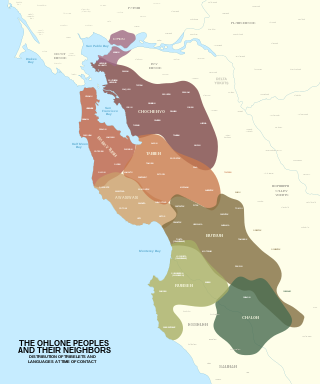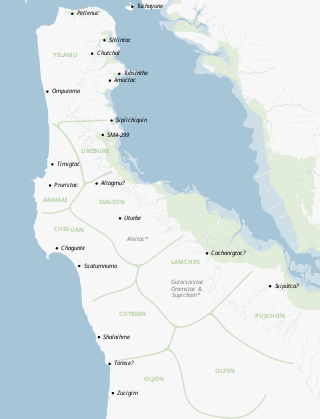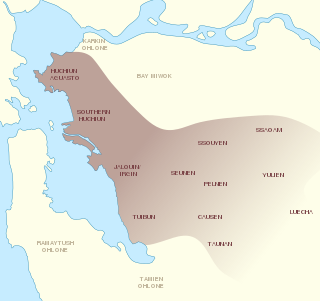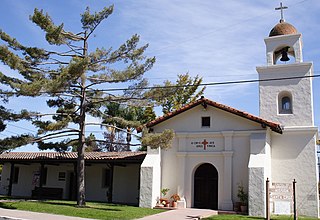
The Ohlone, formerly known as Costanoans, are a Native American people of the Northern California coast. When Spanish explorers and missionaries arrived in the late 18th century, the Ohlone inhabited the area along the coast from San Francisco Bay through Monterey Bay to the lower Salinas Valley. At that time they spoke a variety of related languages. The Ohlone languages make up a sub-family of the Utian language family. Older proposals place Utian within the Penutian language phylum, while newer proposals group it as Yok-Utian.

The Rumsen language is one of eight Ohlone languages, historically spoken by the Rumsen people of Northern California. The Rumsen language was spoken from the Pajaro River to Point Sur, and on the lower courses of the Pajaro, as well as on the Salinas and Carmel Rivers, and the region of the present-day cities of Salinas, Monterey and Carmel.
The Bay Miwok are a cultural and linguistic group of Miwok, a Native American people in Northern California who live in Contra Costa County. They joined the Franciscan mission system during the early nineteenth century, suffered a devastating population decline, and lost their language as they intermarried with other native California ethnic groups and learned the Spanish language.

Utian is a family of Indigenous languages spoken in Northern California, United States. The Miwok and Ohlone peoples both spoke languages of the Utian language family. It has recently been argued that the Utian languages and Yokuts languages are sub-families of the Yok-Utian language family. Utian and Yokutsan have traditionally been considered part of the Penutian language phylum.

The Ramaytush or Rammay-tuš people are a linguistic subdivision of the Ohlone people of Northern California. The term Ramaytush was first applied to them in the 1970s, but the modern Ohlone people of the peninsula have claimed it as their ethnonym. The ancestors of the Ramaytush Ohlone people have lived on the peninsula—specifically in the area known as San Francisco and San Mateo county—for thousands of years. Prior to the California Genocide, the Ohlone people were not consciously united as a singular socio-political entity. In the early twentieth century anthropologists and linguists began to refer to the Ramaytush Ohlone as San FranciscoCostanoans—the people who spoke a common dialect or language within the Costanoan branch of the Utian family. Anthropologists and linguists similarly called the Tamyen people Santa Clara Costanoans, and the Awaswas people Santa Cruz Costanoans.
The Karkin language is an extinct Ohlone language. It was formerly spoken in north central California, but by the 1950s there were no more native speakers. The language was historically spoken by the Karkin people, who lived in the Carquinez Strait region in the northeast portion of the San Francisco Bay estuary.

The Chalon people are one of eight divisions of the Ohlone (Costanoan) people of Native Americans who lived in Northern California. Chalon is also the name of their spoken language, listed as one of the Ohlone languages of the Utian family. Recent work suggests that Chalon may be transitional between the northern and southern groups of Ohlone languages.

Mutsun is a Utian language spoken in Northern California. It was the primary language of a division of the Ohlone people living in the Mission San Juan Bautista area. The Tamien Nation and Amah Mutsun band is currently working to restore the use of the language, using a modern alphabet.

The Awaswas, also known as the Santa Cruz people, were a group of the Indigenous peoples of California in North America, with subgroups historically numbering about 600 to 1,400. Academic research suggests that their ancestors had lived within the Santa Cruz Mountains region for approximately 12,000 years. The Awaswas maintained regular trade networks with regional cultures before the Spanish colonists began settling in the area from the 18th century.

The Tamien people are one of eight linguistic divisions of the Ohlone (Costanoan) people groups of Native Americans who live in Northern California. The Tamien traditionally lived throughout the Santa Clara Valley. The use of the name Tamien is on record as early as 1777, it comes from the Ohlone name for the location of the first Mission Santa Clara on the Guadalupe River. Father Pena mentioned in a letter to Junipero Serra that the area around the mission was called Thamien by the native people. The missionary fathers erected the mission on January 17, 1777, at the native village of So-co-is-u-ka.

The Chochenyo are one of the divisions of the Indigenous Ohlone (Costanoan) people of Northern California. The Chochenyo reside on the east side of the San Francisco Bay, primarily in what is now Alameda County, and also Contra Costa County, from the Berkeley Hills inland to the western Diablo Range.
The Chalon language is one of eight Ohlone languages, historically spoken by the Chalon people of Native Americans who lived in Northern California. Also called Soledad, it belongs to the one of the Ohlone languages of the Utian family. Recent work suggests that Chalon may be transitional between the northern and southern groups of Ohlone languages.
The Tamyen language is one of eight Ohlone languages, once spoken by Tamyen people in Northern California.
The Ramaytush language is one of the eight Ohlone languages, historically spoken by the Ramaytush people who were indigenous to California. Historically, the Ramaytush inhabited the San Francisco Peninsula between San Francisco Bay and the Pacific Ocean in the area which is now San Francisco and San Mateo Counties. Ramaytush is a dialect or language within the Ohlone branch of the Utian family. The term Ramaytush was first applied to it during the 1970s.

The Rumsen are one of eight groups of the Ohlone, an indigenous people of California. Their historical territory included coastal and inland areas within what is now Monterey County, California, including the Monterey Peninsula.
The Karkin people are one of eight Ohlone peoples, indigenous peoples of California.

Awaswas, or Santa Cruz, is one of eight Ohlone languages. It was historically spoken by the Awaswas people, an indigenous people of California.
Chochenyo is the spoken language of the Chochenyo people. Chochenyo is one of the Ohlone languages in the Utian family.












